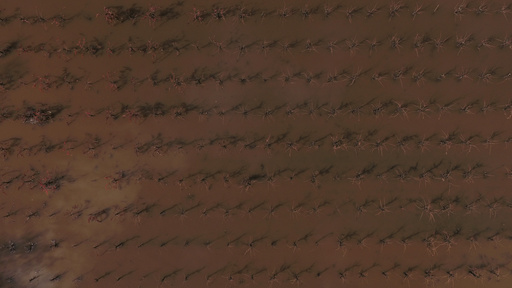
Windsor, California – Weather experts across the United States are warning that impending winter weather could disrupt travel plans in the run-up to the Thanksgiving holiday. Meanwhile, California and Washington state continue to deal with the aftermath of recent storms, including damages and extended power outages.
In California, a tragic incident occurred when a body was discovered inside a vehicle that had been submerged in floodwaters last Saturday. Authorities are now preparing for additional rainfall while also addressing the issues of flooding and minor landslides stemming from a previous storm. In the Pacific Northwest, numerous residents remain without electricity after several days of outages.
The National Weather Service office in Sacramento has issued a winter storm warning for the Sierra Nevada mountains from Saturday through Tuesday. Heavy snowfall is anticipated at higher altitudes, with wind gusts possibly reaching 55 mph (88 kph). Forecasts predict a total snowfall of around 4 feet (1.2 meters), with the most significant accumulation expected late Monday and into Tuesday.
Regions in the Midwest and Great Lakes are likely to experience both rain and snow on Monday, while the East Coast is expected to feel the brunt of the weather impact on Thanksgiving and Black Friday. A low-pressure system is predicted to bring rainfall to the Southeast early Thursday before it moves northward to the Northeast. Areas spanning from Boston to New York may experience rain and strong winds, with potential snowfall in northern New Hampshire, northern Maine, and the Adirondacks. If the storm veers further inland, predictions suggest less snow and more rain in the mountainous areas.
This week, the West Coast faced a deadly ‘bomb cyclone,’ which resulted in the deaths of two individuals in the Pacific Northwest. The storm knocked out power for hundreds of thousands of people, particularly in the Seattle area, before high winds swept through Northern California. As the rapidly intensifying ‘bomb cyclone’ hit, it unleashed damaging winds that impacted homes and vehicles.
Rescue teams in Guerneville, California, discovered a body inside a vehicle floating in floodwaters on Saturday morning, according to Sonoma County Sheriff’s Deputy Rob Dillion. The individual is presumed to be a victim of the storm, although an autopsy is still pending. Santa Rosa reported its wettest three-day period on record, accumulating about 12.5 inches (32 centimeters) of rain by Friday evening, which led to severe flooding in nearby vineyards in Windsor.
In the Seattle region, around 80,000 residents were still experiencing power outages following what has been described as this season’s strongest atmospheric river. The atmospheric river is characterized by a long plume of moisture moving from the ocean onto land. After being without electricity since Tuesday, Katie Skipper from North Bend had her power restored in the afternoon. Although she faced numerous difficulties, such as cold showers and relying on a generator, she noted that her troubles were minor compared to the significant damage suffered by others in the community.
The Northeast received much-needed rainfall due to another storm system affecting New York and New Jersey, where wildfires have recently raged. In northeastern Pennsylvania, heavy snow fell, significantly benefiting the region’s drought conditions after an exceptionally dry autumn. Bryan Greenblatt, a meteorologist with the National Weather Service in Binghamton, remarked that while it may not completely eliminate the drought, the precipitation would be beneficial once it melts.
In the Pocono Mountains, higher elevations received snowfall totals reaching up to 17 inches (43 centimeters), with lesser amounts in the valley cities of Scranton and Wilkes-Barre. The power outages affected less than 80,000 customers across ten counties. Additionally, rainfall in West Virginia provided some relief from the worst drought seen in over 20 years and assisted ski resorts in preparing for the upcoming winter season.
